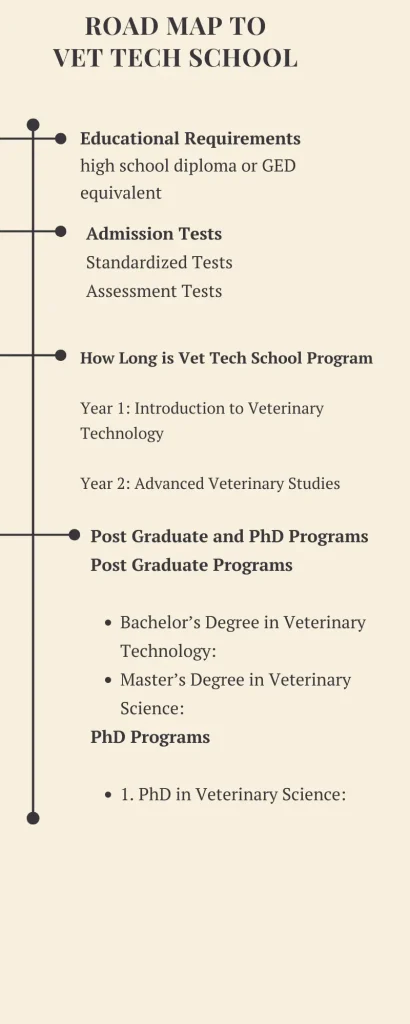How Long is Vet Tech School
How Long is Vet Tech School? Vet tech programs typically take about two years to complete. These programs, offered at community colleges and technical schools, lead to an Associate of Applied Science in Veterinary Technology. Some bachelor’s degree programs may take four years for those seeking advanced opportunities in the field.
What is Vet Tech School
Vet tech school is an educational program designed to train students to become veterinary technicians. These programs cover essential topics such as animal anatomy, physiology, pharmacology, and clinical procedures, preparing students for roles in veterinary clinics, animal hospitals, and other animal care settings.

Students in vet tech school gain hands-on experience through laboratory work, internships, and clinical rotations. The curriculum is designed to ensure graduates are equipped with the skills and knowledge needed to assist veterinarians in diagnosing and treating animals, performing medical tests, and providing compassionate care to animals in various settings.
How Long is Vet Tech School
Year 1: Introduction to Veterinary Technology
Semester 1:
Introduction to Veterinary Technology
Animal Anatomy and Physiology I
Veterinary Medical Terminology
Basic Animal Care and Handling
Semester 2:
Animal Anatomy and Physiology II
Veterinary Pharmacology
Veterinary Office Management
Basic Clinical Procedures
Year 2: Advanced Veterinary Studies
Semester 3:
Advanced Clinical Procedures
Veterinary Surgical Nursing
Laboratory Animal Science
Diagnostic Imaging
Semester 4:
Veterinary Anesthesia
Veterinary Dentistry
Internship/Externship
Capstone Project

How Long is Vet Tech School
Educational Requirements for Vet Tech School
High School Diploma or GED: Required for admission.
Prerequisite Courses: Biology, Chemistry, and Mathematics courses are often required.
GPA Requirements: Most programs require a minimum GPA, usually around 2.5 to 3.0.
Entry Tests for Vet Tech School
Standardized Tests: Some programs may require SAT or ACT scores.
Assessment Tests: Placement tests in math and science may be needed.
Application Process for Vet Tech School
Application Form: Complete the application form provided by the institution.
Transcripts: Submit official high school transcripts and any college transcripts.
Letters of Recommendation: Provide letters from teachers or professionals in the veterinary field.
Personal Statement: Write an essay detailing your interest in veterinary technology.
Interview: Some programs may require an interview as part of the admissions process.
Financial Aids for Vet Tech School
Federal Financial Aid:
FAFSA: Fill out the Free Application for Federal Student Aid to determine eligibility for federal grants, loans, and work-study programs.
State Financial Aid:
Grants and Scholarships: State-specific grants and scholarships may be available for eligible students.
Institutional Aid:
Scholarships: Many schools offer merit-based and need-based scholarships.
Work-Study Programs: Part-time work opportunities provided by the school to help pay for education expenses.
Private Financial Aid:
Loans: Private loans from banks or credit unions.
Scholarships: Scholarships from private organizations or foundations related to veterinary technology.
Post Graduate and PhD Programs for Vet Tech School
Post Graduate Programs:
Bachelor’s Degree in Veterinary Technology:
Duration: Typically 1-2 years after completing an Associate’s Degree.
Focus: Advanced veterinary practices, leadership, and specialized fields such as emergency and critical care.
Master’s Degree in Veterinary Science:
Duration: 2-3 years.
Focus: Research, teaching, and specialized clinical practice. Prepares graduates for leadership roles or further academic pursuits.
PhD Programs:
- PhD in Veterinary Science:
Duration: 4-6 years.
Focus: In-depth research, academic teaching, and advanced clinical practices. Prepares graduates for careers in academia, research institutions, or high-level clinical positions.
Top 10 Vet Tech Schools

1.Purdue University
Location: West Lafayette, Indiana
Notable for: Comprehensive curriculum and extensive clinical training opportunities.
2.University of Georgia
Location: Athens, Georgia
Notable for: Strong emphasis on hands-on experience and research.
3.Colorado State University
Location: Fort Collins, Colorado
Notable for: Renowned veterinary teaching hospital and research facilities.
4.Michigan State University
Location: East Lansing, Michigan
Notable for: Advanced clinical practices and research opportunities.
5.University of Missouri
Location: Columbia, Missouri
Notable for: Integrated curriculum with a focus on both large and small animals.
6.Texas A&M University
Location: College Station, Texas
Notable for: Extensive facilities and diverse clinical rotations.
7.Cornell University
Location: Ithaca, New York
Notable for: Prestigious faculty and cutting-edge research programs.
8.University of Illinois
Location: Urbana-Champaign, Illinois
Notable for: Strong emphasis on community service and clinical experience.
9.Ohio State University
Location: Columbus, Ohio
Notable for: Comprehensive training and advanced veterinary technology programs.
10.Kansas State University
Location: Manhattan, Kansas
Notable for: Focus on rural veterinary practices and community outreach.
Factors Affecting the Length of Vet Tech School
Program Type:
Associate’s Degree: Typically takes 2 years.
Bachelor’s Degree: Takes an additional 2 years after an Associate’s Degree.
Course Load:
Full-Time vs. Part-Time: Full-time students complete programs faster than part-time students.
Program Structure:
Online vs. On-Campus: Online programs may offer more flexibility, potentially affecting duration.
Accelerated Programs: Some schools offer accelerated tracks that shorten the overall length of the program.
Clinical Requirements:
Internships and Externships: Mandatory clinical hours may extend the program length depending on availability and scheduling.
Transfer Credits:
Previous Education: Credits from previous coursework can shorten the time needed to complete the program.
Institutional Policies:
Course Availability: The frequency and availability of required courses can impact program length.
Academic Performance: Students needing to retake courses may extend their time in the program.
Final Verdict
Choosing to pursue a career as a veterinary technician involves careful consideration of the time commitment and educational requirements. With various program lengths and opportunities for advanced degrees, aspiring vet techs can find a path that fits their career goals and personal circumstances.
FAQs
1.How long is vet tech school?
Most vet tech programs take about two years to complete, resulting in an Associate’s Degree in Veterinary Technology. Bachelor’s programs may take an additional two years.
2.What are the prerequisites for vet tech school?
Typically, you need a high school diploma or GED, and coursework in biology, chemistry, and mathematics. Some programs also require standardized test scores and a minimum GPA.
3.Are there online vet tech programs?
Yes, many institutions offer online vet tech programs, which provide flexibility for students. These programs still require hands-on clinical experience, which must be completed in person.
4.What financial aid options are available for vet tech students?
Financial aid options include federal and state grants, scholarships, work-study programs, and private loans. Filling out the FAFSA is essential to determine eligibility for these aids.
5.What career opportunities are available for vet tech graduates?
Veterinary technicians can work in various settings, including veterinary clinics, animal hospitals, research facilities, zoos, and animal shelters. Advanced degrees may lead to specialized roles or teaching positions.
